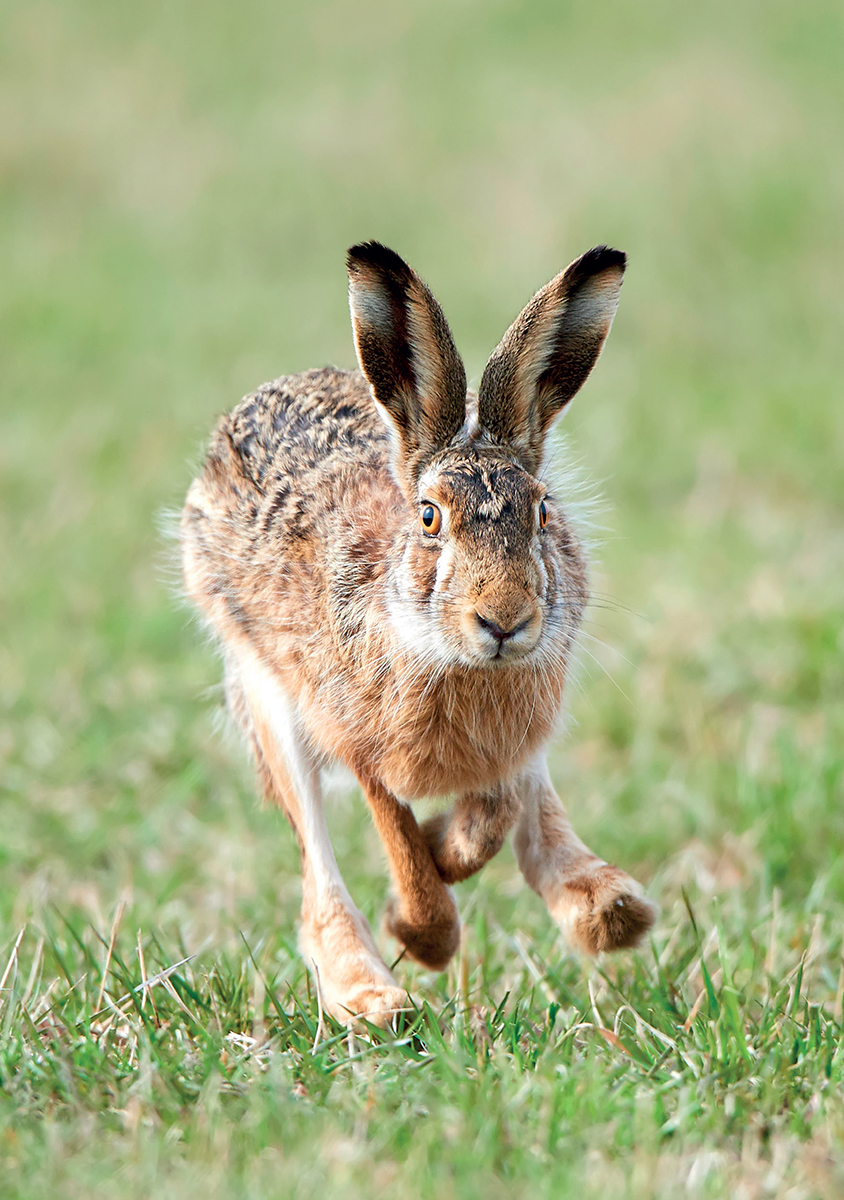
The Brown Hare has a speedy lifestyle. Females produce on average 10 leverets per year, but only live for a couple of years.

The Brown Hare has a speedy lifestyle. Females produce on average 10 leverets per year, but only live for a couple of years.
The Lives of Hares
You might think that hares spend their lives calmly munching grass at night and quietly resting, alone, during the day, and you would be right. However, underlying their timid, peaceful behaviour is a ‘live fast, die young’ strategy that has evolved under constant pressure from predators.
Speedy lifestyles
Many large mammal species have evolved to live for a relatively long time, breed slowly and invest precious time and energy in caring for their few young, while small mammals have evolved to breed quickly and many times during their short lives. In fact, there is a ‘fast–slow continuum’ along which each species has evolved to have its own place.
At the slow end of the scale, we have the whales and elephants. For example, the North Atlantic Right Whale may live for up to 70 years. Females give birth to one calf at a time, starting at about 10 years of age, after a gestation period of one year, and then breed only every three to four years. Over her long lifetime, a female Right Whale has on average only five or six young. You can see why the recovery of this species since whaling was stopped in the 1930s has been extremely slow.
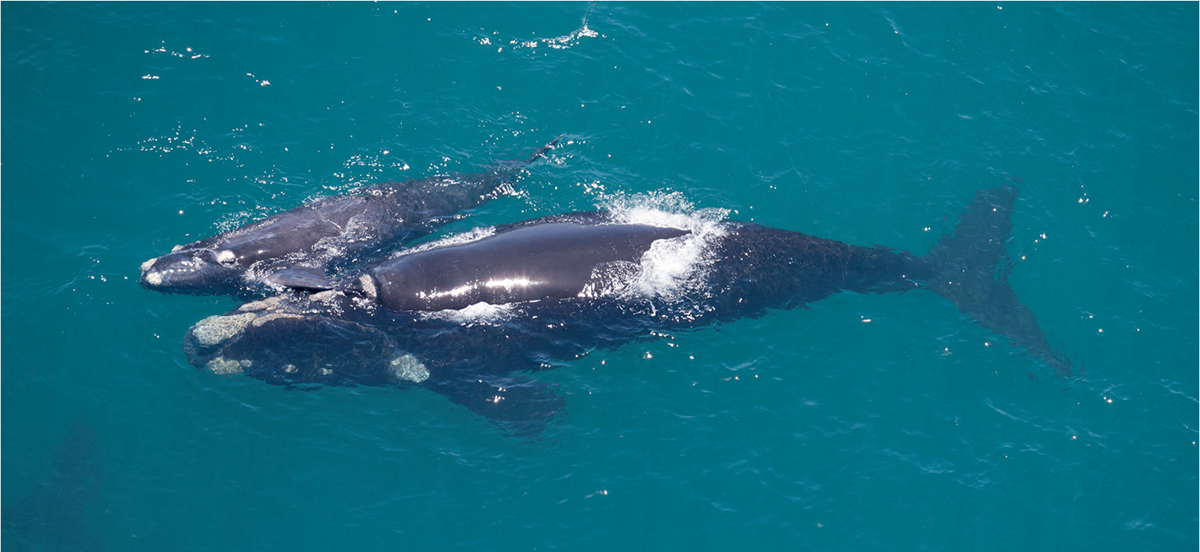
A female Right Whale with a calf. She will give birth only five or six times during her long life.
At the fast end of the scale, we find the mice and rats. For example, a female House Mouse can breed at just 30 days old, and the gestation period is 20 days. She gives birth to a litter of 3–14 babies, and soon becomes pregnant again, though she lives for, on average, only one year. Populations of mice are able to increase very rapidly, and they can therefore make the most of any changes in their environment and recover quickly from declines.
The position of each species on the ‘fast–slow continuum’ can be predicted from its body size: small animals live fast; large animals live more slowly. Hares and rabbits, for their size, breed unexpectedly quickly and don’t live as long as expected, so, like rodents, they are able to recover quickly from any declines and exploit changing environments. They are able to live ‘in the fast lane’ because their food is mostly plentiful and readily available. Female Brown Hares can breed at three to seven months old, give birth to 1–12 (typically four) leverets per litter, become pregnant again soon after giving birth, and have up to five litters per year. The average number of leverets produced by each female Mountain Hare in Scotland each year is estimated to be six; for Brown Hares in England, this number is 10. Rabbits, as you might expect, also breed ‘like rabbits’, but their naked young are born after a shorter gestation period.
Baby hares and rabbits grow exceptionally fast, both in the womb and after they are born. However, many young hares do not survive to adulthood. The population size of Brown Hares varies more due to changes in adult survival rates than it does due to the survival of young hares. Each year, about half of all adult Brown Hares die, while many more young die before they breed. Survival depends on many factors, including weather conditions and the time of year of birth – leverets born in early spring are much more likely to survive their first winter than those born in late summer, and can sometimes breed before their first winter. Wild Brown Hares are estimated to live for, on average, two to three years; the oldest marked individual was at least 12 and a half years old. Most deaths occur in the hard winter months, especially in Mountain Hares.
Daily routines
Most herbivores, including hares, spend a lot of time feeding. For mainly nocturnal or crepuscular animals like the hare, the short summer nights present a challenge: how can they fit in enough feeding time? The answer, for hares, is to start early and finish late. In summer, Brown Hares often leave their forms a few hours before sunset, while in winter they have a lie in until up to one hour after sunset. In summer, Brown Hares return to their forms up to five hours after sunrise, while in winter they return before the sun comes up. Following a similar pattern, Mountain Hares are most likely to be active in daylight at the start and at the end of the long summer days. They are active for about 13 hours each night in winter, but only for eight to nine hours in spring and summer. Mountain Hares in Sweden spend up to half of their active time in daylight in summer.

This Brown Hare made its form in a cereal stubble field, but will need to find young green plants – weeds, crops or grass – to eat. It may need to spend time and energy traveling to a suitable feeding site.
During the day, hares often rest in their forms with their ears back and their eyes partly closed. They also spend time grooming, usually at the beginning of their daytime rest period. From their forms, hares keep a good look out for approaching predators and listen for them too. If predators or humans approach too closely, hares leave their forms and bound away, usually travelling uphill (easy when you have short front legs and long hind legs), and relying on their speed to avoid capture. The average distance at which an approaching human causes a Mountain Hare to leave its form has been measured in Scotland and in Finland; it is between 5m and 54m (16 and 177ft), depending on the air temperature. Strangely, hares seem to be more ‘flighty’ in colder weather. So, if you want to get close to a hare in its form, try to do so on a warm day – you should be able to get closer than on a cold day. It may be easiest to approach Brown Hares on wet days or when the ground is muddy – under these conditions they are not keen to leave their forms, because running in mud is hard work.
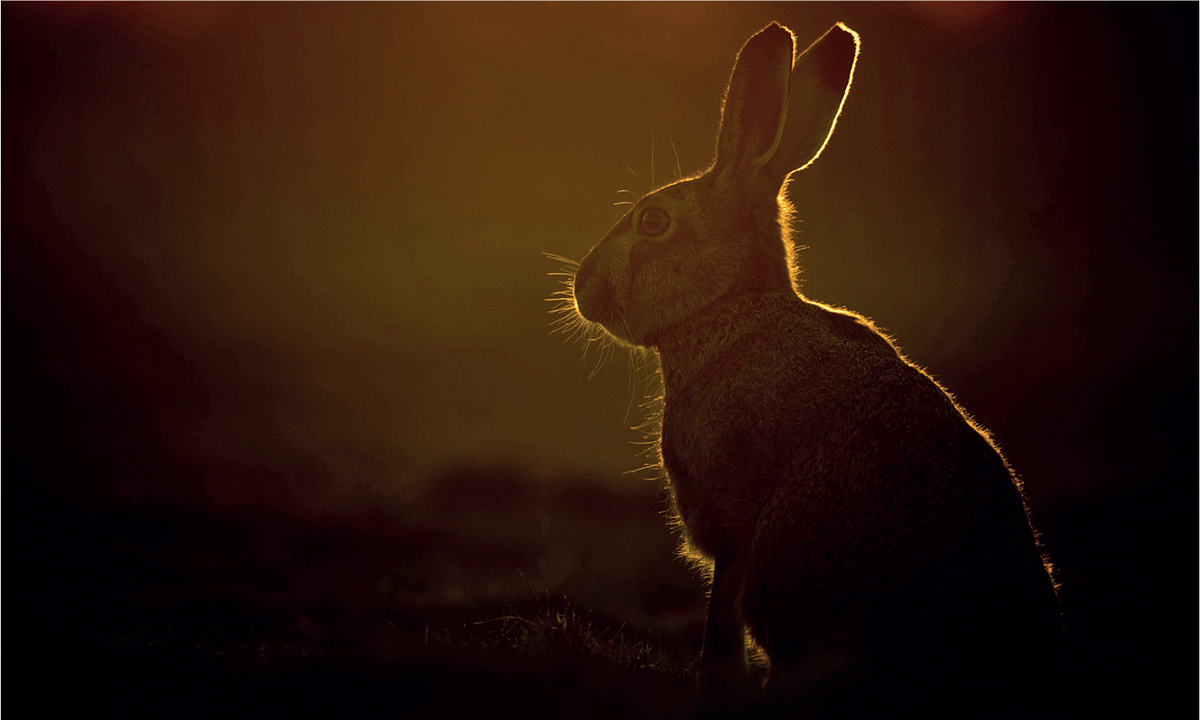
In summer, the short nights make it hard for hares to fit in enough feeding time.

For both Mountain Hares (left) and Brown Hares (right), the feet are important tools for escaping from predators, so it pays to keep them in good condition.
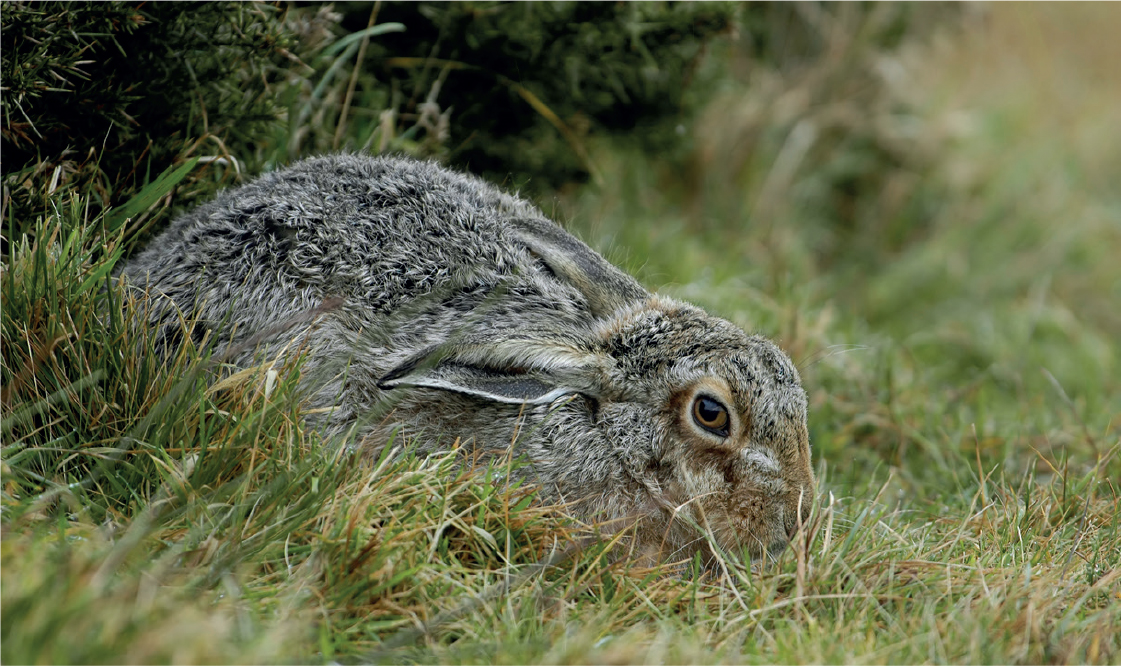
Brown Hares tend to stay put in wet weather.
The main event – feeding
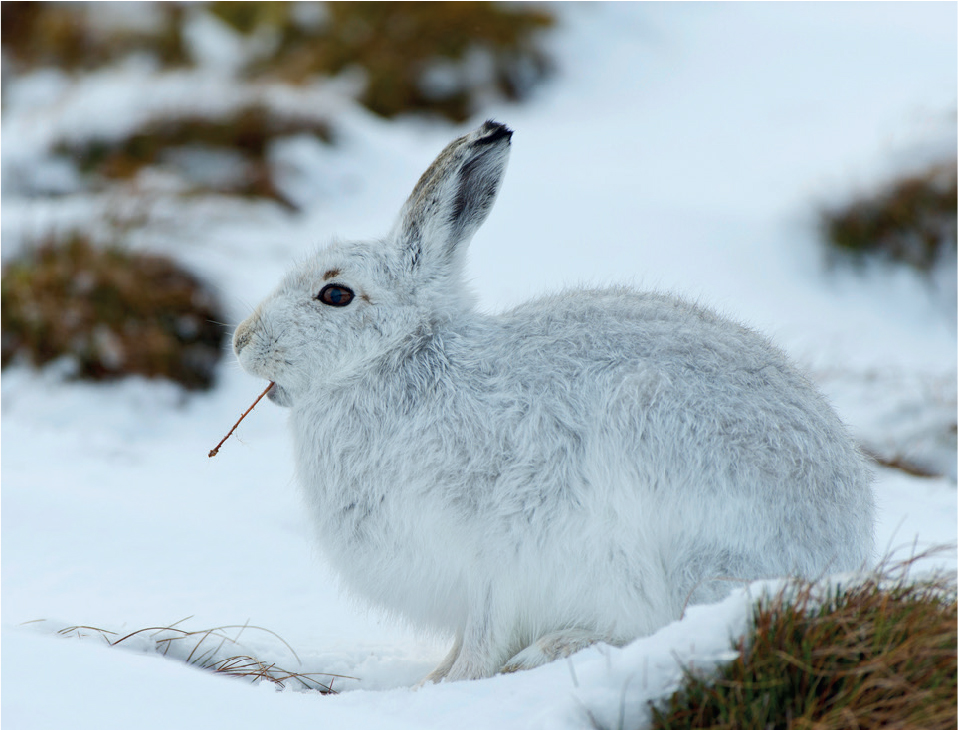
Mountain Hares look around and swivel their ears while feeding, in case a predator approaches.
After they leave their forms in the evening, female hares may need to feed their young, but this only takes a few minutes (see here). In dry weather, hares sometimes roll in dust to clean themselves and remove parasites. Some time may be spent seeking mates, boxing potential mates or mating, but hares’ main activity away from their forms is feeding. Hares are selective feeders and travel to the best areas where they can find the choicest morsels: the youngest, freshest plants and those with the highest energy, oil or sugar content. Scottish Mountain Hares usually travel downhill to feed, perhaps to make returning to their form easier (as long hind legs make for easier uphill travel). While feeding, hares are constantly looking and listening for predators and are ready to flee if necessary. The best fields may be covered with hares at night.
Groups of feeding Brown Hares of both sexes are sometimes structured so that the biggest and bossiest hares – those at the top of the hierarchy – get the best food. Once it has been established by boxing, maintaining the hierarchy requires almost no fighting, which suggests that, though hares are mostly solitary, they recognise each other and know who is boss. When they form groups, Brown Hares are also able to spend more time feeding because they can share the responsibility of looking out for predators.
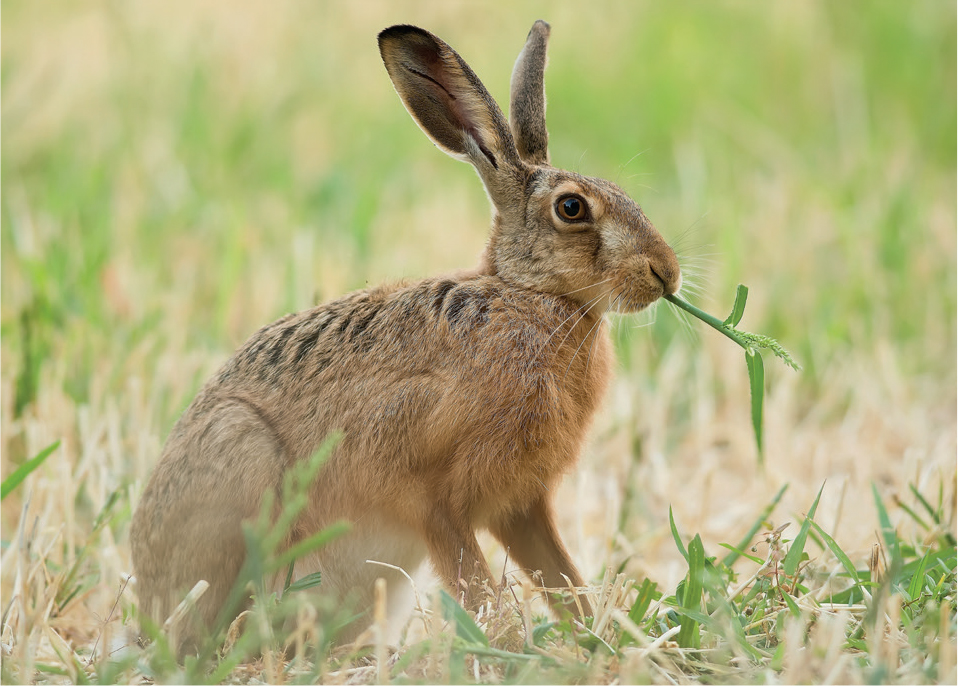
Brown Hares spend a lot of time eating grass.
When returning to their forms at the end of the night, Brown Hares take an unpredictable route and sometimes make a couple of huge leaps, perhaps to baffle predators using scent to follow them. As additional protection, some hares have a few favourite forms that they use in rotation, moving every few days.
How many hares?
Counting hares to estimate the size of populations is difficult, but it has been attempted. Various methods have been used, including daytime walks to count hares in their forms, drives in which hares are flushed from their forms and counted, and counts of droppings or tracks, to derive what ecologists call an index of abundance. But counts made with different methods are difficult to compare, and there are added complications: were the counts made in spring, of the pre-breeding population, or in autumn, when numbers are swelled by the addition of youngsters, many of which may die during the winter?
Perhaps the best and most commonly used method is spotlight counting. Spotlight counts are conducted at night when hares are active. Researchers venture out armed with powerful torches and count the hares they see in the beam of light as they move it around in a circle from fixed points, or they point it into the darkness from a moving vehicle to create a strip of light. The eyes of hares, like those of many other mammals, have a reflective layer of tissue (the ‘tapetum lucidum’) behind the retina. This is an adaptation for life in low light – it allows the available light to be reflected back through the retina to maximise its use for vision. The tapetum lucidum also causes distinctive eyeshine, which helps hares to show up in spotlight counts.
From the numbers counted and an estimation of the area covered, or by using a mathematical estimation of visibility at different distances, the density of hares (numbers per sq km) can be calculated for different habitats or at different times. Researchers can also get an idea of where hares feed and whether they form groups or feed individually.
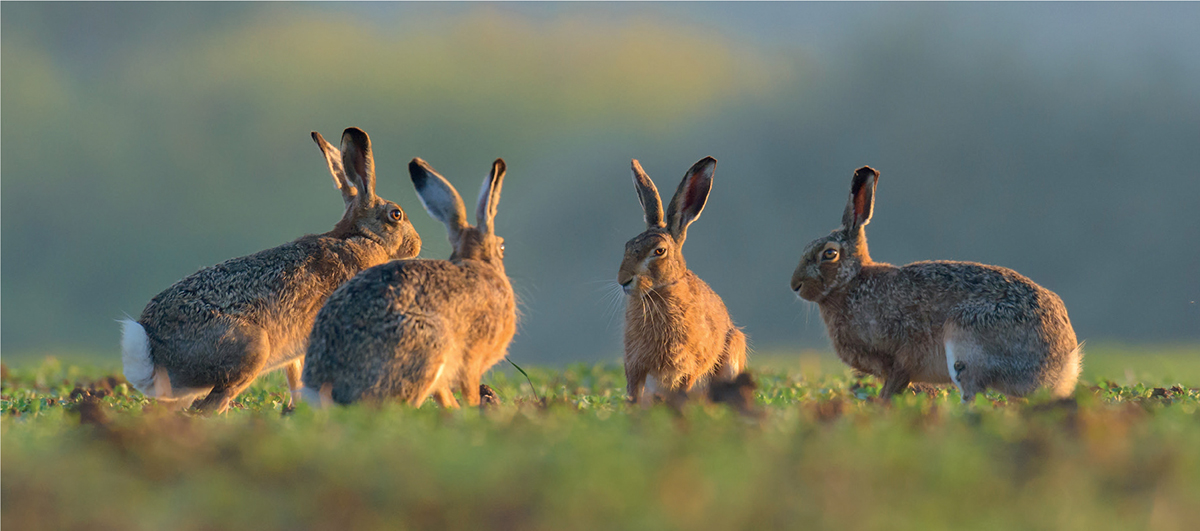
In most places it is unusual to see Brown Hares in groups. This photograph was taken on arable land in Germany, where Brown Hare density is high. It may show three males that are all interested in the same female as a potential mate, or a group of hares feeding.
In most places where they have been counted, Mountain Hares reach densities of fewer than 10 individuals per sq km (26 per sq mile), but in some places, especially on islands, densities can reach a few hundred per sq km. In the optimum areas of north-east Scotland, densities may, exceptionally, reach 245 Mountain Hares per sq km (635 per sq mile). Densities of Brown Hares vary depending on the time of year and the habitat, but are on average 20–35 hares per sq km (around 52–91 per sq mile). One population on a small Danish island with few predators reached 200 hares per sq km (518 per sq mile), and populations in the best arable habitats may reach similar levels, especially in autumn. In some parts of Europe, well over 20 Brown Hares per sq km (52 per sq mile) are shot each year.

A researcher in Scotland using a radio antenna to locate a Mountain Hare that has been fitted with a radio transmitter.
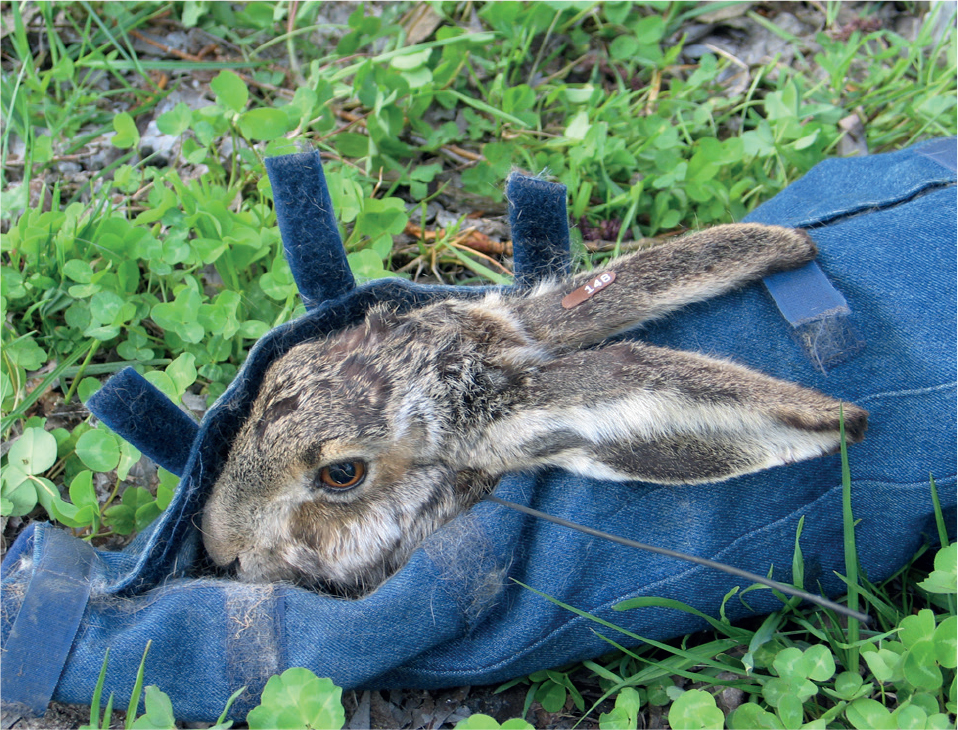
This Brown Hare, caught by Austrian researchers and fitted with a small ear tag for identification, is now ready for release. The blue bag was used to restrain the animal during handling.
Researchers tracking hares by radio telemetry found that their ‘home ranges’, the areas they occupy, are large and overlapping. Hares show no signs of being territorial, though as adults they do tend to stay in the same area. Mountain Hares in Scotland may travel a few kilometres to find suitable feeding grounds and, depending on the food available, may occupy an area of a few hectares (ha) to several square kilometres when they are feeding. Males usually travel slightly further than females and have bigger home ranges. For Brown Hares, home ranges are 20–190ha (49–470 acres), depending on the habitat.
Finding new places to live
If all the animals that were born into a population stayed where they were born, they may soon run out of food, and inbreeding would probably occur. To prevent this, animals disperse (permanently move away from their birthplace). Like young adult humans feeling the need to get away from their parents, other young animals, particularly males in mammals, instinctively move away and settle in a new area to breed. Female mammals also disperse, but are more likely than males to stay where they were born and eventually breed there.
Dispersal allows hares to colonise new areas and allows different populations to interact and interbreed; it has been described by ecologists as the glue that sticks local populations together. About half of all Brown Hares of four to six months old disperse, moving 1–17km (⅔–11 miles). There is much less evidence of dispersal in Mountain Hares; no dispersal is documented in Scotland. In Sweden, less than one third of young hares fitted with radio transmitters dispersed, and they did not go far.
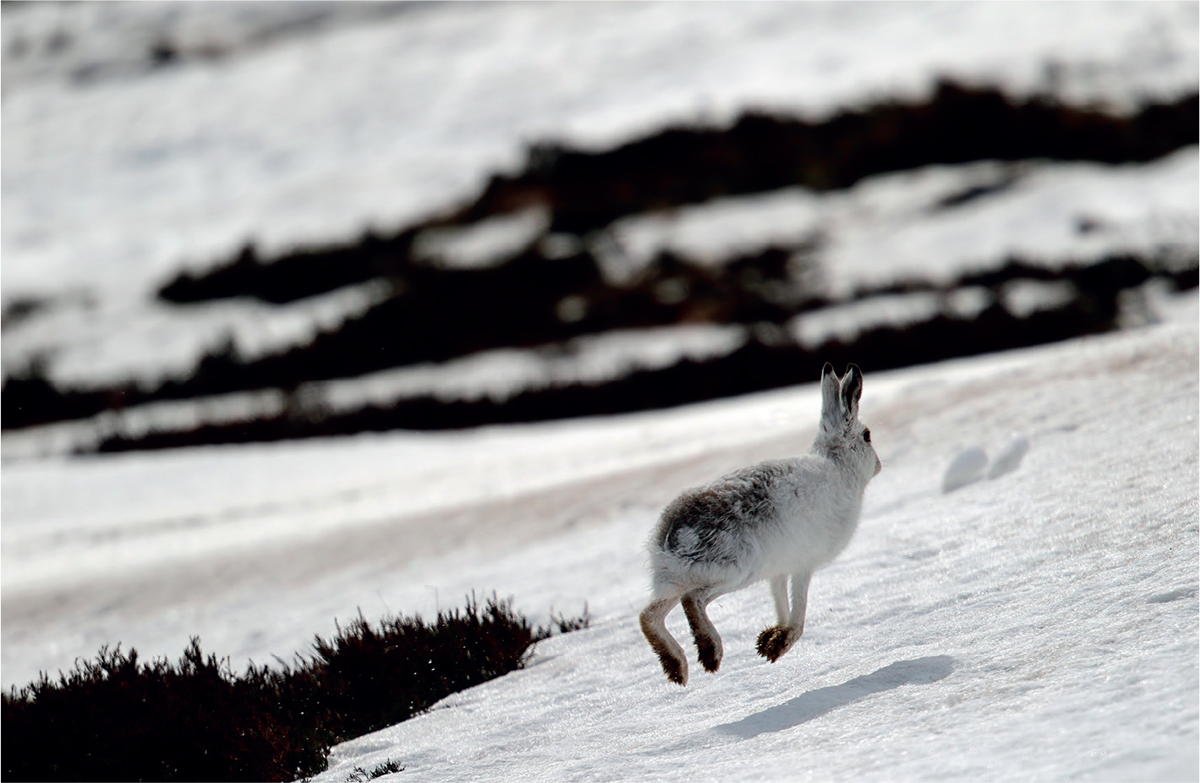
The snow is starting to melt around this Scottish Mountain Hare, and with perfect timing, its coat is moulting to match the landscape.